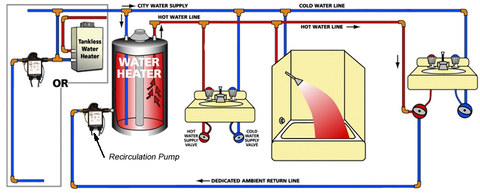This simple device can not only save you money, it can also deliver nearly instant hot water. A hot water circulation pump keeps the hot water constantly moving through the home's plumbing system, so when a hot water tap is opened, the water will be hot right away.
How your home plumbing works without a circulation pump
- When a hot water tap is closed, the water flow stops.
- When no hot water is needed the water sits within the pipes and cools.
- When the hot water tap is once again opened, the cool water that has sat stagnant within the plumbing needs to be "pushed" through the pipes before the hot water from the water heater reaches the tap.
Bottom line: There is a lot of wasted water going down the drain. Over the course of a year this can add up to hundreds of litres (and dollars)!
How your home plumbing services will work with a circulation pump
- Once the hot water tap is closed the hot water will stop temporarily at the tap before it begins to circulate through the plumbing of the house again.
- When no hot water is needed the water within the pipes circulates on a continuous basis in preparation for the next hot water demand.
- When the hot water tap is opened, hot water is delivered nearly immediately.
Bottom Line: When a hot water tap is opened water is hot, saving time and money.There is a lot of waste water going down the drain while you wait for hot water.

Here are a few of the benefits:
- Ease of Installation - Circulation pumps are fairly easy to install. No special permits or special tools are usually required, although we always recommend a plumber is employed, and there are many models designed specifically for home plumbing systems.
- Selection - There are many manufacturers and options available.
- Convenience - Hot water is available nearly immediately when a tap is opened. The convenience of having nearly instantaneous hot water is a huge draw for home owners.
- Ease of Operation - Most units are very easy to operate. Once they are set you seldom need to make any adjustments.
- Water Usage - Less water is wasted since hot water is delivered nearly immediately. In areas where water is in short supply this is especially helpful. A significant amount of water can be saved every year.
There are 3 main types of circulation pumps
1. Basic Circulation Pump
This System uses a small pump that is constantly circulating water thru the home's main water lines, also known as trunk lines or supply lines. If the water isn't used, it is returned back to the water heater.
Since this basic system is running continuously, it places a tremendous amount of unnecessary wear on your water heater (and your wallet through the power bill). We do not recommend this type of system.
2. On-Demand Circulation Pump
An on-demand system operates when there is a demand for hot water. If a hot water faucet is opened a motion detector, or flow switch, will trigger the pump to turn on. Once the pump turns on, it will continue to circulate the water through the pipes until the water reaches a set temperature.
These systems tend to be a little more expensive and can range in price significantly depending on the size of your house, however, these are the systems we normally recommend.
Pros
- There's an option to override the motion detector so the pump can be manually activated.
- Hot water is delivered quickly, saving time, water and money.
- An On-Demand system can reduce the energy demand of your water heater, therefore, saving money on your utility bills.
- For retrofitted homes, the crossover of hot water into the cold water plumbing will be reduced.
- Hot water is not delivered absolutely instantaneously because the pump will need to activate.
- The way your house is plumbed will determine the amount of time needed to deliver hot water.
- For retrofitted homes a power source and a pump will need to be used at each hot water loop.
3. Timer Circulation Pump
A Timer system allows you to program the pump to match your hot water needs. You can set the adjustable timer to the times you'll need hot water. For example, if you always take a shower at 7am and run the dishwasher at 8:30am, you may want to set the pump to cycle on at 6am and cycle off at 10:30am.
Pros
- The pump settings can be adjusted easily.
- Both the time and temperature settings need to be triggered for the hot water to circulate through your plumbing.
- Settings can be overridden if needed.
- Hot water is nearly instantaneous, potentially saving time, money and water.
- This system can increase your energy usage if it's overused.
- Retrofitted homes could experience issues at the faucet farthest from the water heater. The cold water lines could be heated.
- Your routine may change but the pumps settings will not
A hot water circulation pump could well be the answer to all your water heating woes, no more standing shivering and watching litres of frigid water cascade down the plughole as you wait for the warm water to finally arrive. Browse our selection today but as always, speak to a heating, plumbing and gas specialist to help select the perfect pump for your home.

